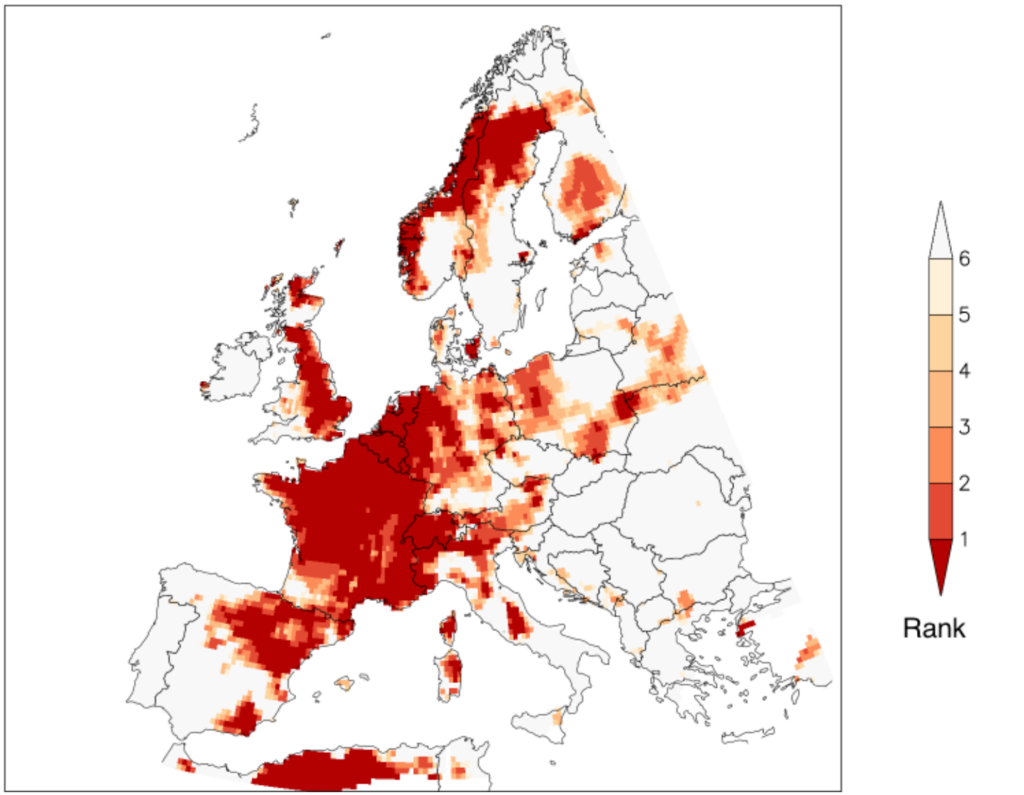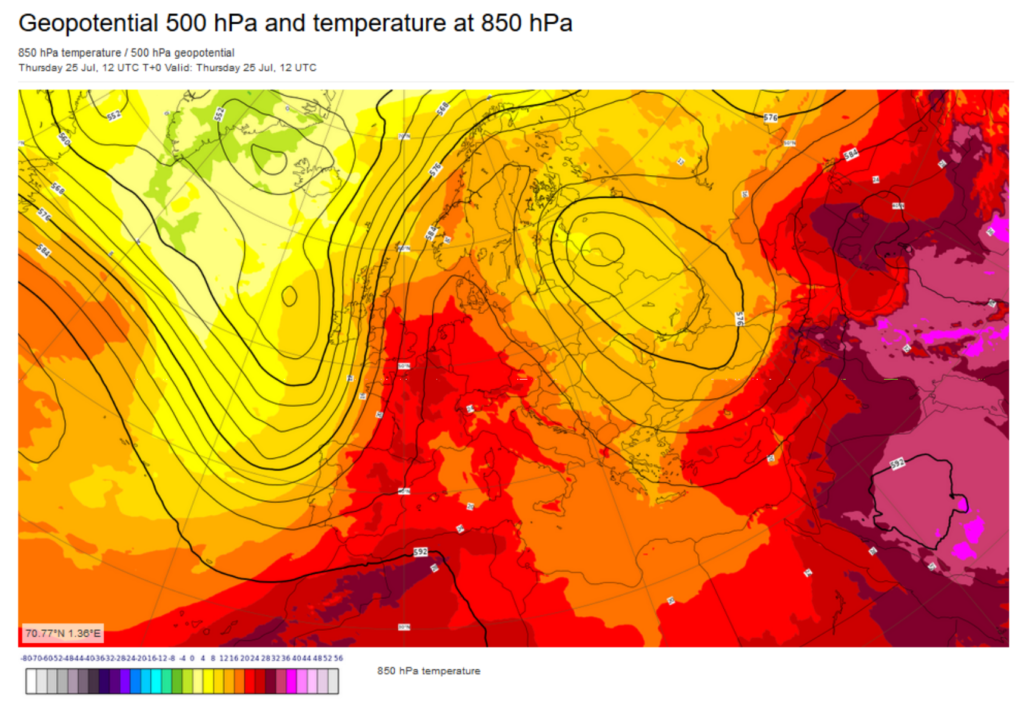European heatwave made up to 100 times more likely due to global warming – “The July 2019 heatwave was so extreme over Europe that the observed magnitudes would have been extremely unlikely without climate change”

2 August 2019 (University of Oxford) – Record-breaking July 2019 heatwave would have been extremely unlikely without human-induced climate change in many parts of continental Europe, shows a near real-time analysis from World Weather Attribution and partners including Oxford’s Environmental Change Institute (ECI).
Over two to four days at the end of July 2019, Western Europe saw temperatures reach 42.6 degrees in Paris, while the UK set a new daily temperature record at 38.7 degrees. The effects of these extreme temperatures are far-reaching: from delayed trains and sleepless nights, to deaths from drowning and an increased mortality risk for the elderly, babies and vulnerable populations.
An international team of scientists, including researchers from the ECI, the Dutch Met office (KNMI), the UK Met Office and Météo France, conducted a rapid analysis to determine whether and to what extent the probability of these heatwave events had changed as a result of climate change. The analysis was led by World Weather Attribution, an international effort to analyse the possible influence of climate change on extreme weather events such as heatwaves, cold spells, and droughts.
Combining established modelling methodologies and observational data, the researchers found that in France and the Netherlands, the heatwave was made about one hundred times (and at least 10 times) more likely due to climate change. This means that before global warming a similar heatwave would have been extremely improbable, with a chance of happening only once in a thousand years.
Combining information from models and observations, we find that such heatwaves in France and the Netherlands would have had return periods that are about a hundred times higher (at least 10 times) without climate change. Over France and the Netherlands, such temperatures would have had extremely little chance to occur without human influence on climate (return periods higher than ~1000 years).
Vautard, et al., 2019 / World Weather Attribution
In Germany the heatwave was made around 50 times more likely due to climate change (and at least 8 times more likely), and in the U.K. – where extreme temperatures only lasted 1-2 days – the heatwave was made at least twice as likely.
In all regions the researchers found that without climate change, heatwave temperatures would have been 1.5 to 3 degrees lower.
Dr Friederike Otto, acting director of the Environmental Change Institute, said: ‘Every European heatwave we and others have analysed was found to be made much more likely and more intense due to human-induced climate change so it was not surprising that climate change played a role.’
She added, ‘But how much more likely the heatwave is depends very strongly on the event definition: location, season, intensity and duration. This July 2019 heatwave was so extreme over continental Western Europe that the observed magnitudes would have been extremely unlikely without climate change.’
Dr Karsten Haustein, a researcher in Dr Otto’s team said, ‘Heat waves are dangerous, in particular for older people prone to suffering from heatstroke and other related problems. Mortality increases with hot nights and days. Effective heat action plans can help to mitigate risks but we need to think beyond that. Trees and white roofs are a fairly simple solution. Better insulated houses and in general more investments to safeguard infrastructure that is bound to fail at high temperatures are also critical.’
European heatwave made up to 100 times more likely due to climate change

Human contribution to the record-breaking July 2019 heatwave in Western Europe
2 August 2019 (World Weather Attribution) – After the extreme heat that took place in the last week of June 2019, a second record-breaking heat wave struck Western Europe and Scandinavia at the end of July 2019.
In June, new all-time records were set in multiple places across Western Europe. In July, records were broken again, albeit in different areas. Again, the role of climate change in producing such high-amplitude events was questioned.
This study assesses how human-induced climate change has altered the likelihood and intensity of the July event or similar events. It uses a large number of climate simulations that were available at the time of study (8 ensembles of 10 to over 100 simulations each). We define the event as the class of events exceeding the observed values of daily mean temperatures averaged over 3 days for a few locations in Western Europe. Three days in a row of high temperatures are often considered as the minimal length for a hot spell to have potential health impacts.
We combined information from both long series of observations and climate model simulations in order to obtain best estimates of changes in probability and intensity of an event like (or more severe than) the observed July extreme temperatures in Western Europe attributable to human-induced climate change. The few observation sites were selected to both include a large July heat wave signature and have long and homogeneous enough records with least perturbations from urban heat island effects. We used statistical models of extremes such as the Generalized Extreme Values model, and applied them to both observations and simulations. This allows us to assess (i) models’ skill to simulate extremes and (ii) how climate change altered the odds of extremes. Models that did not represent heat waves well were withdrawn from the analysis.
Key findings
- A second record-breaking heat wave of 3-4 days took place in Western Europe in the last week of July 2019, with temperatures exceeding 40 degrees in many countries including Belgium and the Netherlands where temperatures above 40°C were recorded for the first time. In the U.K. the event was shorter lived (1-2 days), yet a new historical daily maximum temperature was recorded exceeding the previous record set during the hazardous August 2003 heatwave.
- In contrast to other heat waves that have been attributed in Western Europe before, this July heat was also a rare event in today’s climate in France and the Netherlands. There, the observed temperatures, averaged over 3 days, were estimated to have a 50-year to 150-year return period in the current climate. Note that return periods of temperatures vary between different measures and locations are therefore highly uncertain.
- Combining information from models and observations, we find that such heatwaves in France and the Netherlands would have had return periods that are about a hundred times higher (at least 10 times) without climate change. Over France and the Netherlands, such temperatures would have had extremely little chance to occur without human influence on climate (return periods higher than ~1000 years).
- In the U.K. and Germany, the event is less rare (estimated return periods around 10-30 years in the current climate) and the likelihood is about 10 times higher (at least 3 times) due to climate change. Such an event would have had return periods of from a few tens to a few hundreds of years without climate change.
- In all locations an event like the observed would have been 1.5ºC to 3ºC cooler in an unchanged climate.
- As for the June heatwave, we found that climate models have systematic biases in representing heat waves at these time scales and they show about 50% smaller trends than observations in this part of Europe and much higher year-to-year variability than the observations. Despite this, models still simulate very large probability changes.
- Heatwaves during the height of summer pose a substantial risk to human health and are potentially lethal. This risk is aggravated by climate change, but also by other factors such as an aging population, urbanisation, changing social structures, and levels of preparedness. The full impact is only known after a few weeks when the mortality figures have been analysed. Effective heat emergency plans, together with accurate weather forecasts such as those issued before this heatwave, reduce impacts and are becoming even more important in light of the rising risks.
- It is noteworthy that every heatwave analysed so far in Europe in recent years (2003, 2010, 2015, 2017, 2018, June 2019, this study) was found to be made much more likely and more intense due to human-induced climate change. How much more depends very strongly on the event definition: location, season, intensity and duration. The July 2019 heatwave was so extreme over continental Western Europe that the observed magnitudes would have been extremely unlikely without climate change.
Read the full report (pdf, 1.7 MB).
Human contribution to the record-breaking July 2019 heatwave in Western Europe


